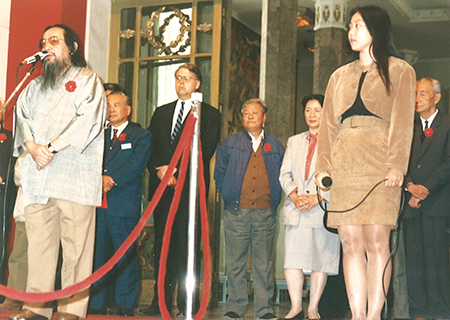
[This is the second of a two part account of the author’s experience in China for his part in a 1992 exhibition of Kazuaki Kita at Beijing’s Museum of the Chinese Revolution. Select "Remembering China (Part 1) from the Columns archive—Ed.]
Back in Beijing, visits to the Forbidden City and the Temple of Heaven were marvelous, striking one with the grandeur of China's past and the far greater equality among its 1.5 billion citizens today. As the sole Western member of a Japanese cultural delegation attending the opening at the Museum of the Chinese Revolution for the Japanese ceramic artist Kazuaki Kita (about whom I had written extensively), I was included in fascinating if wary interchanges between former enemies now trying to be friends. Across from the Forbidden City at the other end of Tiananmen Square lies Chairman Mao’s Tomb behind which is the largest tent-covered Communist Party kitsch souvenir center in the capital city — or perhaps, at the time, the world. The amount of Mao memorabilia was astounding. Before we indulged our yen for white marble busts, however, our group went to the head of the VIP line at the entry to the Tomb and were immediately escorted in to see the embalmed corpse in the glass-topped refrigerated catafalque. As the Chinese guide explained in lightly accented English about the chilly room, “Chairman Mao ... He is very ... fresh!”
On another day, during a visit to a model public school, I was impressed when one group member, a retired Japanese public school teacher, politely questioned Chinese school officials as to whether their system's emphasis on paramilitary training beginning at primary-school levels was perhaps excessive. The Chinese replied that the children’s parents were part of the Army elite and approved of the approach because “This is what life is like.” While both peoples may now be friends, the Japanese have had greater success at downplaying military influences in public education than the Chinese. This remains an essential difference between them despite the 42 years that have passed since normalization of diplomatic and commercial relations in 1972.
The bicycles, the swarms of people lined up to see Chairman Mao's tomb in Tiananmen Square, the air pollution, the imperial architecture — these are my memories of Beijing. Shanghai is also densely populated and suffers from considerable air pollution but, as a result of former colonial architecture downtown, it seems less exotic, more western, truly once the "Paris of the East." This made me appreciate Beijing all the more.
Who could fail to be moved by the treasures of the old Shanghai Museum, from ancient bronzes to masterpieces of ceramics, painting and calligraphy? After our guided tour of the collection, there was a brief ceremony awarding Mr. Hosaka and myself titles of Research Advisors to Shanghai Teachers University complete with calligraphed dedications on bright pink paper. Needless to say, I was extremely moved and grateful. In my brief acceptance remarks (translated on the spot into Chinese and Japanese), I reminded the guests present that ceramics is a bridge across all the world: “The first two steps on the bridge are China and Japan.” No one present, except perhaps the stray North Korean exchange student, could have disagreed.
That evening, after an afternoon spent at the Shanghai Acrobatic Theater, we had the rare privilege of attending a wedding dinner at a great local restaurant. Shanghai crabs, more exquisite soups and seafood specialties were all washed down with innumerable toasts to the happy couple and, as previously, to Japanese-Chinese friendship, with Tsingtao beer, fine rice wine, and the powerful liqueur Mao-tai. With so many good wishes, Professor and Mrs. Zhang have hopefully enjoyed a long and beautiful marriage. After the wedding party, our group boarded a deluxe bus for a nighttime tour of Shanghai. I reached my dormitory room at the Teachers University quite late but fell asleep easily.
With members of the wedding couple’s families present at the dinner and the by now close-knit Kita delegation in attendance (all the way from Tokyo), I felt more than ever how much China and Japan have in common and how, in a new world of mutual understanding and shared cultural goals, these two nations have a bright future. To have been in China at this time, to have seen Mr. Kita's exhibition, and to have witnessed the depth of mutual respect and appreciation was truly an honor for me as an art critic and as a citizen of the United States. Living in Seattle, I firmly believe that the next 100 years will be the "Pacific Century". For me, that century began October 5, 1992. China and Japan are already crucial players in making it happen.
